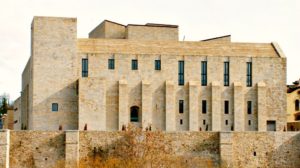
Locality: PAMPLONA (31001)
Address: Calle Dos de Mayo, s/n
Zone: The Pamplona Basin
Centuries of construction: XII
Telephones: 848 424 667 / 848 424 623
Description
Occupying the site which, in years past, was the Palace of the Kings of Navarra, the Royal and General Archive of Navarra, deep within the same city walls, is one of the most ancient and emblematic historical buildings in Navarre. This ancient palace, recovered for its current task after various decades of abandonment, and whose origins go back to the 12th century, served as the residence of the bishops of Pamplona and the monarchs of this old Kingdom in medieval times. Around 1530 it was inhabited by the vice-regents and since 1841 by the captain-generals. It was later the seat of the Military Government. The rehabilitation project is the work of the Navarrese architect Rafael Moneo, and it was inaugurated as a documentary deposit in 2003 by the King and Queen of Spain. The Royal and General Archive is situated in the historical quarter of Pamplona only a few metres away from the Museum of Navarre, opposite the picturesque basilica of San Fermin de Aldapa (17th century) and in the heart of the city walls.
Its history goes back to the 12th century, when King Sancho VI ?el Sabio’ (the Wise) began its construction. It was the subject of successive disputes over its ownership between the Church and the Crown, and changed hands frequently. It was initially the residence of the monarchs and then of the vice-regents from 1539. From 1841 onwards it was home to captains, generals and military governors, from whence it received its various names: Palace of the Kings, of the Vice-regent or of the Captaincy.
The prestigious architect Rafael Moneo was the person responsible for its subsequent restoration and rehabilitation as the new seat of the General Archive of Navarra, and in the 2003 it was inaugurated by the King and Queen of Spain.
The Royal Archive offers a singular image in which the old façade of the Palace is integrated with elements of the new construction. From its past it has retained intact the vaulted Gothic room, dedicated to exhibitions of the most important documents of the Archive. The interior porched courtyard is now glazed and has a beautiful ornamental garden in the centre.
Dependencies
The three-storey building is joined to a structure of eleven floors -most of them below ground level- used as the document archive. It is equipped with the most advanced systems for classification, consultation, conservation and guardianship of the documentary inheritance of Navarre. There is a wide atrium leading to the various levels, with a beautiful skylight at the top that allows natural light to enter at any hour of the day.
The ground floor of the old Royal Palace houses an assembly room and a reading room and study with 18 places. The first floor is occupied by the library and the offices, and on the second floor (as well as being the upper part of the library), one finds the restoration, photographic and microfilm workshops.
The documents of the Kingdom, to which resources of other institutions were later added, constitute the nucleus of the Royal and General Archive of Navarra, the place where all the documentation from the ancient Cortes (Parliament) of Navarre and its Diputación (Territorial Administration) is conserved, from the end of the 15th century until 1836.
The institutional sections of the Archive are as follows: Kingdom, Public Accounts, Royal Tribunals, Vice-regencyship, Clergy, Charities, Civil Government, Territorial High Court, Government Protocols, Mortgage Accounts office, Taxation Delegation, Municipal Archives, Personal Archives, ancient codes, maps and iconographs, a photographic archive and library resources.
You need a researcher’s card to consult the documentary resources; the card is available in the Archive offices.







